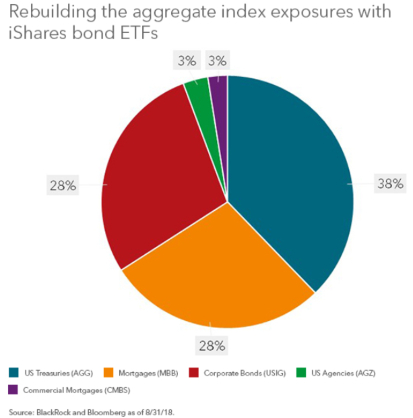Bond investing has tended to keep a relatively low profile – the alleged province of bond geeks, lacking the splashy media coverage of stocks. While the performance of the S&P and the Dow are avidly followed, when was the last time you overheard an elevator conversation about how the Agg did that day?
Yet for the past 40 years, some form of the Agg – the Bloomberg Barclays U.S. Aggregate Bond Index – has served as the foundational benchmark for the bond portion of most U.S. portfolios. Its the first stop for financial advisors and other asset allocators, who look at the risk-return profile of the Agg to gauge the percentage and type of bonds they should hold.
A revolutionary idea
Exchange traded funds (ETFs) that track the S&P 500 and other broad stock market indexes have been in existence for a quarter century, but until 2003 there were few options for investors to gain exposure to the performance of the U.S. Aggregate Bond Index. Instead, most people bought individual bonds or looked to actively managed funds for the bond portion of their portfolios. While each approach has its uses, there can be downsides: bond buying can be cumbersome and costly, especially for smaller investors; active funds typically try to outperform the index by overweighting higher-yielding sectors or adjusting duration (interest rate risk).
The launch of the iShares Core U.S. Aggregate Bond ETF (AGG) revolutionized and democratized bond investing. It was the first ETF to provide all investors with a low-cost, transparent way to own the worlds predominant fixed income benchmark. Just like stock ETFs, shares of AGG could be conveniently traded on exchange — tapping into a ready market of buyers and sellers instead of being confined to the over-the-counter system for individual bonds. These innovations have helped AGG grow to over $56 billion in assets.
Whats more, the fund was low cost. Originally, the expense ratio was 0.22%, which was about one-fifth the cost of the average active manager, according to Morningstar. Today, AGGs net expense ratio is just 5 basis points (0.05%[1]). And the average bid-ask spread of AGG is just 0.01% — a fraction of the cost of buying individual bonds, using data from NYSE ARCA as of 8/31/18.

The parts of its sum
The creation of AGG provided broad bond market exposure. Over the next few years, iShares launched ETFs designed to track the major components of the index. This made it possible to slice the Aggregate index into sub-sector ETFs: Treasuries, investment-grade corporates, mortgage- and asset-backed securities, and agency obligations. Like the broader index, these subsectors would be difficult for smaller investors to replicate on their own. Investors actively manage these index ETFs by over- or underweighting sectors based on their goals or market views.

This, too, was revolutionary. The ability to break the index into smaller building blocks gave investors even more control over their bond portfolios, conveniently and cost effectively. It allowed them to adjust the interest rate risk, income potential and diversification properties of their fixed income portfolio based on their specific investment needs. Investors can also diversify outside the U.S. with the iShares Core International Aggregate Bond ETF (IAGG).
Fifteen years ago, there were only a handful of bond ETFs. Today, there are more 1,200 of them, trading in a market worth $840 billion globally (source: BlackRock, as of 8/31/2018). AGG opened the door toward a more modern and transparent bond market.
[1] BlackRock Fund Advisors (“BFA”), the investment adviser to the Fund and an affiliate of BlackRock Investments, LLC, has contractually agreed to waive a portion of its management fees through June 30, 2026. Please see the Funds prospectus for additional details.
Karen Schenone, CFA. is an iShares Fixed Income Product Strategist



